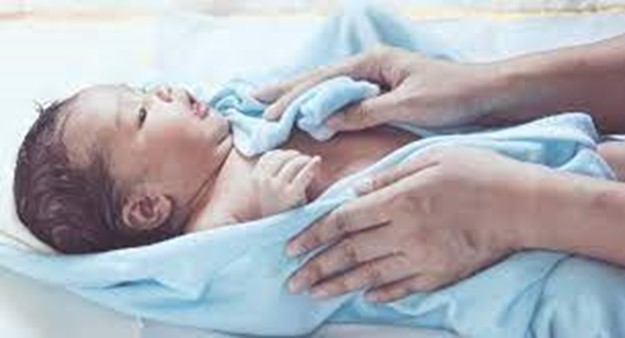A nurse is caring for a newborn immediately following delivery. After assuring a patent airway, which of the following actions should be the nurse's priority?
Dry the newborn.
Administer phytonadione IM.
Document the Apgar score.
Apply identification bands.
The Correct Answer is A
Choice A reason:

Drying the newborn's skin thoroughly is the nurse's priority after assuring a patent airway because it reduces evaporative heat loss by the newborn and prevents cold stress. Cold stress can lead to hypoxia, hypoglycemia, acidosis, and increased bilirubin levels. Drying the newborn also stimulates breathing and crying, which are signs of a healthy newborn.
Choice B reason:
Administering phytonadione IM is not the nurse's priority because it is not an immediate life-saving intervention. Phytonadione is given to prevent hemorrhagic disease of the newborn, which is caused by vitamin K deficiency. However, this condition usually occurs after the first day of life, so administering phytonadione can be delayed until after the initial assessment and stabilization of the newborn.
Choice C reason:
Documenting the Apgar score is not the nurse's priority because it is not an action that directly affects the newborn's well-being. The Apgar score is a tool to assess the newborn's condition at 1 and 5 minutes after birth based on five criteria: heart rate, respiratory effort, muscle tone, reflex irritability, and color. The Apgar score can help guide the nurse's interventions, but it is not more important than providing care to the newborn.
Choice D reason:
Applying identification bands is not the nurse's priority because it is not an urgent or essential action. Identification bands are used to ensure the safety and security of the newborn and prevent errors or mix-ups. However, applying identification bands can be done after the newborn is dried, warmed, and assessed for any problems.
Nursing Test Bank
Naxlex Comprehensive Predictor Exams
Related Questions
Correct Answer is C
Explanation
Choice A reason:
Intermittent abdominal pain following passage of bloody mucus is not a sign of placenta previa, but rather of bloody show, which is a normal occurrence in late pregnancy as the cervix begins to dilate and efface.
Choice B reason:
Abdominal pain with minimal red vaginal bleeding is not a sign of placenta previa, but rather of abruptio placentae, which is a serious complication where the placenta detaches from the uterine wall before delivery.
Choice C reason:
A large amount of bright red vaginal bleeding without pain is a sign of placenta previa, which is a condition where the placenta covers part or all of the cervical opening. This can cause bleeding when the cervix dilates or contracts, especially in the third trimester. This is a medical emergency that requires immediate attention.
Choice D reason:
Severe abdominal pain with increasing fundal height is not a sign of placenta previa, but rather of uterine rupture, which is a rare but life-threatening complication where the uterus tears open along the scar line from a previous cesarean delivery or other uterine surgery. This can cause severe bleeding, fetal distress, and shock.
Correct Answer is ["A","C","D"]
Explanation
Choice A reason:
Swimming is one of the best exercises for pregnant women because it provides moderate aerobic conditioning with minimal stress on your joints. It also supports your increased weight and helps you stay cool and comfortable.
Choice B reason:
Scuba diving is not a safe exercise for pregnant women because it poses a high risk of injury to the baby. The baby has no protection against decompression sickness and gas embolism, which are caused by changes in pressure underwater.
Choice C reason:
Walking is a great exercise for beginners and can be done throughout pregnancy. It improves your cardiovascular fitness, strengthens your muscles and bones, and helps prevent excessive weight gain and gestational diabetes.
Choice D reason:
Yoga can be beneficial for pregnant women as it can improve flexibility, balance, posture, breathing and relaxation. It can also reduce stress, anxiety and back pain. However, some yoga poses may not be suitable for pregnancy, so it is advisable to join a prenatal yoga class or consult a qualified instructor.
Choice E reason:
Snow skiing is not recommended for pregnant women because it involves a high risk of falling and affecting your balance. Falls can cause damage to your baby or placenta, especially in the second and third trimesters.
Whether you are a student looking to ace your exams or a practicing nurse seeking to enhance your expertise , our nursing education contents will empower you with the confidence and competence to make a difference in the lives of patients and become a respected leader in the healthcare field.
Visit Naxlex, invest in your future and unlock endless possibilities with our unparalleled nursing education contents today
Report Wrong Answer on the Current Question
Do you disagree with the answer? If yes, what is your expected answer? Explain.
Kindly be descriptive with the issue you are facing.
